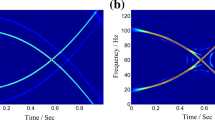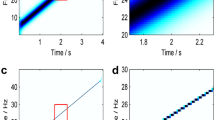Abstract
The instantaneous frequency (IF) provides important characteristic information for analyzing signals. To improve the accuracy of IF estimation, time–frequency (TF) analysis with high resolution and high aggregation is necessary. A new IF estimation method is proposed in this paper, which is referred to as ridge path regrouping based on an adaptive short-time Fourier high-order synchrosqueezing transform (AFSST). In the TF analysis of the non-stationary signal, we optimize the window function of the short-time Fourier transform to be adaptive to signal characteristics, and then perform the high-order synchrosqueezing transform. Based on the high-resolution time–frequency distribution (TFD), the frequency ridge of the signal is extracted, and the ridge of the modal aliasing at the intersection is discarded and reorganized according to the fundamentals. Experiments on multicomponent nonstationary signals were performed, and the results show that AFSST has satisfactory TF aggregation and TF resolution. IF estimation experiment based on AFSST, the results indicate that the proposed method can estimate the IF accurately even under a low signal-to-noise ratio (SNR).








Similar content being viewed by others
References
J. Akram, N.A. Khan, S. Ali, Multi-component instantaneous frequency estimation using signal decomposition and time-frequency filtering. SIViP 14, 1663–1670 (2020). https://doi.org/10.1007/s11760-020-01711-6
S. Ali, N.A. Khan, X. Luo, Blind source separation schemes for mono-sensor and multi-sensor systems with application to signal detection. Circuits Syst. Signal Process. 36, 4615–4636 (2017). https://doi.org/10.1007/s00034-017-0533-6
S.M. Beeraka, A. Kumar, M. Sameer, Accuracy enhancement of epileptic seizure detection: a deep learning approach with hardware realization of STFT. Circuits Syst. Signal Process. 41, 461–484 (2022). https://doi.org/10.1007/s00034-021-01789-4
B. Boashash, P.J. Black, An efficient real-time implementation of the Wigner-Ville distribution. IEEE Trans. Acoust. Speech Signal Process. 35(11), 1611–1618 (1987). https://doi.org/10.1109/TASSP.1987.1165070
B. Boashash, Estimating and interpreting the instantaneous frequency of a signal-Part 1: fundamentals. IEEE Proc. 80(4), 520–538 (1992). https://doi.org/10.1109/5.135376
B. Boashash, Estimating and interpreting the instantaneous frequency of a signal-Part 2: algorithms and applications. IEEE Proc. 80, 540–568 (1992). https://doi.org/10.1109/5.135378
V. Bruni, M. Tartaglione, D. Vitulano, A pde-based analysis of the spectrogram image for instantaneous frequency estimation. Mathematics 9(3), 247 (2021). https://doi.org/10.3390/math9030247
S. Chen, X. Dong, G. Xing, Z.K. Peng, W.M. Zhang, G. Meng, Separation of overlapped non-stationary signals by ridge path regrouping and intrinsic chirp component decomposition. IEEE Sens. J. 17(18), 5994–6005 (2017). https://doi.org/10.1109/JSEN.2017.2737467
I. Daubechies, J. Lu, H.T. Wu, Synchrosqueezed wavelet transforms: an empirical mode decomposition-like tool. Appl. Comput. Harmon Anal. 30(2), 243–261 (2011). https://doi.org/10.1016/j.acha.2010.08.002
I. Daubechies, S. Maes, A Nonlinear Squeezing of the Continuous Wavelet Transform Based on Auditory Nerve Models, in Wavelets in Medicine and Biology. ed. by A. Aldroubi, M. Unser (CRC Press, London, 1996), pp.527–546. https://doi.org/10.1201/9780203734032-20
I. Djurovic, L.J. Stankovic, An algorithm for the Wigner distribution based instantaneous frequency estimation in a high noise environment. Signal Process. 84(4), 631–643 (2004). https://doi.org/10.1016/j.sigpro.2003.12.006
I. Djurovic, QML-RANSAC instantaneous frequency estimator for overlapping multicomponent signals in the time-frequency plane. IEEE Signal Process. Lett. 25(3), 447–451 (2018). https://doi.org/10.1109/LSP.2018.2795554
I. Djurovic, RANSAC algorithm for instantaneous frequency estimation and reconstruction of frequency-modulated undersampled signals. EURASIP J. Adv. Signal Process. 2021, 19 (2021). https://doi.org/10.1186/s13634-021-00726-6
H.U. Zhong-Lai, Z.H. Jian-Zhong, Z.O. Zhi-Hui, A second-order synchrosqueezing S-transform and its application in seismic spectral decomposition. Chin. J. Geophys. 60, 2833–2844 (2017). https://doi.org/10.6038/cjg20170728
L. Jiang, L. Li, G.Q. Zhao, Y. Pan, Instantaneous frequency estimation of nonlinear frequency-modulated signal under strong noise environment. Circuits Syst. Signal Process. 35, 3734–3744 (2016). https://doi.org/10.1007/s00034-015-0230-2
Q.T. Jiang, B.W. Suter, Instantaneous frequency estimation based on synchrosqueezing wavelet transform. Signal Process. 138, 167–181 (2017). https://doi.org/10.1016/j.sigpro.2017.03.007
N.A. Khan, S. Ali, A robust and efficient instantaneous frequency estimator of multi-component signals with intersecting time-frequency signatures. Signal Process. 177, 107728 (2020). https://doi.org/10.1016/j.sigpro.2020.107728
N.A. Khan, M. Mohammadi, I. Stankovic, Sparse reconstruction based on iterative TF domain filtering and Viterbi based if estimation algorithm. Signal Process. 166, 107260 (2020). https://doi.org/10.1016/j.sigpro.2019.107260. (ISSN 0165-1684)
N.A. Khan, M. Mohammadi, Detection of frequency modulated signals using a robust if estimation algorithm. Circuits Syst Signal Process. 39(4), 2223–2231 (2020). https://doi.org/10.1007/s00034-019-01258-z
L. Li, H.Y. Cai, H.X. Han, Q.T. Jiang, H.B. Ji, Adaptive short-time Fourier transform and synchrosqueezing transform for non-stationary signal separation. Signal Process. 166, 10723 (2020). https://doi.org/10.1016/j.sigpro.2019.07.024
L. Li, H.Y. Cai, Q.T. Jiang, Adaptive synchrosqueezing transform with a time-varying parameter for non-stationary signal separation. Appl. Comput. Harmon. Anal. 49(3), 1075–1106 (2020). https://doi.org/10.1016/j.acha.2019.06.002
P. Li, Q.H. Zhang, IF estimation of overlapped multicomponent signals based on viterbi algorithm. Circuits Syst. Signal Process. 39, 3105–3124 (2020). https://doi.org/10.1007/s00034-019-01314-8
T. Oberlin, S. Meignen, V. Perrier, The Fourier-based synchrosqueezing transform. ICASSP. in IEEE International Conference on Acoustics, Speech and Signal Processing. Florence, Italy, pp. 315–319 (2014). https://doi.org/10.1109/ICASSP.2014.6853609
D.A. Okaya, E. Karaeorgi, T.V. McEvilly, P.E. Malin, Removing vibrator-induced correlation artifacts by filtering in frequency-uncorrelated time space. Geophysics 57(7), 916–926 (1992). https://doi.org/10.1190/1.1443304
D.H. Pham, S. Meignen, High-order synchrosqueezing transform for multicomponent signals analysis-with an application to gravitational-wave signal. IEEE Trans. Signal Process. 65, 3168–3178 (2017). https://doi.org/10.1109/TSP.2017.2686355
E. Sejdic, I. Djurovic, L. Stankovic, Quantitative performance analysis of scalogram as instantaneous frequency estimator. IEEE Trans. Signal Process. 56(8), 3837–3845 (2008). https://doi.org/10.1109/TSP.2008.924856
S. Sinha, P.S. Routh, P.D. Anno, J.P. Castagna, Spectral decomposition of seismic data with continuous-wavelet transform. Geophysics 70(6), 19–25 (2005). https://doi.org/10.1190/1.2127113
L. Stankovic, I. Djurovic, S. Stankovic, M. Simeunovic, S. Djukanovic, M. Dakovic, Instantaneous frequency in time-frequency analysis: enhanced concepts and performance of estimation algorithms. Digit. Signal Process. 2, 1–13 (2014). https://doi.org/10.1016/j.dsp.2014.09.008
X.F. Su, R. Xiao, M.Z. Zhu, Method for IF estimation of multicomponent FM signals. J. Xid. Univ. 46(1), 51–56 (2019). https://doi.org/10.19665/j.issn1001-2400.2019.01.009
X.X. Zheng, Y.B. Wei, J. Liu, H.S. Jiang, Multi-synchrosqueezing S-transform for fault diagnosis in rolling bearings. Meas. Sci. Technol. 32, 025013 (2021). https://doi.org/10.1088/1361-6501/abb620
P. Zhou, Y. Yang, S. Chen, Parameterized model based blind intrinsic chirp source separation. Digit. Signal Process. 83, 73–82 (2018). https://doi.org/10.1016/j.dsp.2018.08.015
Acknowledgements
This research was funded by the National Natural Science Foundation of China under Grant 61803294 and Natural Science Basic Research Program of Shaanxi (Program No. 2020JQ-684).
Funding
National Natural Science Foundation of China, 61803294, Li Jiang, Natural Science Foundation of Shaanxi Province, 2020JQ-684, Li Jiang.
Author information
Authors and Affiliations
Corresponding author
Ethics declarations
Conflict of interest
The authors declare that they have no conflict of interest.
Ethical Approval
This article does not contain any studies with human participants or animals performed by any of the authors.
Additional information
Publisher's Note
Springer Nature remains neutral with regard to jurisdictional claims in published maps and institutional affiliations.
Appendix A
Appendix A
First, we donate
Then, we obtain the new equations:
When N = 4,
where \(X_{k,j} = Z_{{\alpha_{opt} }}^{g} Z_{{\alpha_{opt} }}^{{t^{k} g}} - Z_{{\alpha_{opt} }}^{{t^{j - 1} g}} Z_{{\alpha_{opt} }}^{{t^{k - j + 1} g}} \;{\text{and}}\;\partial_{f} X_{k,j} = X_{k + 1,j} + X_{k + 1,j - 1} - X_{k + 1,2} .\)
Therefore, we can get
With the help of the back-substitution algorithm, the modulation operators are calculated as:
Finally, we could use \(G_{k}\) and \(G_{j,k}\) to express (52):
where \(G_{k} {(}Z_{{\alpha_{opt} }}^{{t^{0...m} g}} {,}Z_{{\alpha_{opt} }}^{{t^{0...m} g^{\prime}}} {)}\) is a function of \(Z_{{\alpha_{opt} }}^{{t^{l} g}}\) for \(l = 0,...,m\), and \(Z_{{\alpha_{opt} }}^{{t^{l} g^{\prime}}} {\kern 1pt} {\kern 1pt} {\kern 1pt} {\text{for}}{\kern 1pt} {\kern 1pt} {\kern 1pt} l = 0,...,n.\)
Rights and permissions
Springer Nature or its licensor (e.g. a society or other partner) holds exclusive rights to this article under a publishing agreement with the author(s) or other rightsholder(s); author self-archiving of the accepted manuscript version of this article is solely governed by the terms of such publishing agreement and applicable law.
About this article
Cite this article
Jiang, L., Shang, W., Xiang, S. et al. IF Estimation of Multicomponent Nonstationary Signals Based on AFSST. Circuits Syst Signal Process 42, 6116–6135 (2023). https://doi.org/10.1007/s00034-023-02388-1
Received:
Revised:
Accepted:
Published:
Issue Date:
DOI: https://doi.org/10.1007/s00034-023-02388-1




